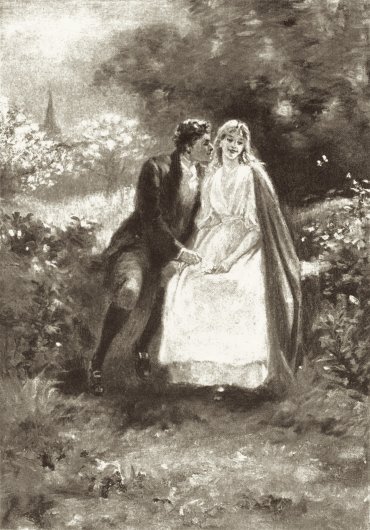In my first published novel (I’ve only had the one, but hey, I’m nothing if not an optimist), I originally set out to write a book that would subvert expectations in that it had no romantic subplot whatsoever. It was about three men setting out on a globe-trotting adventure. No icky girl cooties here! There was lots of questing, but alas, no love story. Well, after a few beta readers got through with it, I caved and added one-and you know what? In that case, the book was better for it.
Then, last summer, I sat down to begin work on a new novel. In the first chapter, I introduce two characters-one of them a man, the other a woman. They’re co-workers, archaeologists working together on a dig in South America. The two characters aren’t romantically involved. They’re just friends.
Well, by Chapter Five I found myself inadvertently writing a paragraph about the man admiring the woman from behind and acknowledging that he’d always been attracted to her.
Whoa! I thought to myself. Where did that come from?
Maybe Harry Burns was right. In When Harry Met Sally, one of the most iconic romantic comedies of all time, Billy Crystal’s character starts off spouting his theory (though he calls it fact) that a man and a woman can’t just be friends. Ignoring the hetero-normative caveat here, his ideas are met with stiff resistance. Every time I watch this movie, I cheer when Sally sets him straight. I mean, what a load of crap! Of course men and women can be friends. My own life is exploding with opposite-sex platonic friendships.
So, it is with great dismay that I watch as the movie progresses to Harry ultimately being proven correct. Perhaps it’s true that men and women can’t “just be friends,” but Harry and Sally eventually fall in love in dramatic Hollywood fashion. (Sorry, folks; no spoiler warnings for twenty-five-year-old movies. Them’s the breaks.) I’m quite the sentimentalist at heart, so this is most likely the only time I’ve actively rooted against a romantic-comedy couple overcoming the odds and making it work. I just don’t like the underlying message.
Indeed, I am a big proponent of platonic relationships in fiction. And yet, I am forced to look at my track record. As in the two examples cited above, I started off writing romance-free relationships and ended up reversing course. I guess that makes me a hypocrite.
The thing is, romance is easy. Now, when I say that, I don’t mean to imply that writing romance doesn’t come with its share of challenges. On the contrary, as the people charged with the uncomfortable task of reading my first drafts know all too well. I’m not the world’s best romance writer. I have to put in two or three times the usual effort for my romantic liaisons to really jump off the page-in a good way, that is.
So why do I say it’s easy? Well, romantic feelings are a wonderful and effective way of motivating your characters to take action. Love causes people to climb mountains, swim oceans, and reach for the stars. The death of a loved one, in particular, can set your story on fire-and this was my motivation, however misguided, for linking my star-crossed archaeologists. You see, in the absence of love, an author has to dig a lot deeper to figure out why characters behave as they do. Adding romantic subplots to spur along a waning story or character is a default move, and it can be used as a crutch when handled inelegantly.
If you are to get your reader deeply invested in a platonic relationship, you’re going to need to get creative. Could When Harry Met Sally have been a satisfying movie if the two characters had merely turned out to be best friends who never developed feelings for each other at all? I’d like to say yes, but I don’t think I’m alone in having a hard time imagining it.
My experiences and observations show me that if it’s true that love makes the world go round, then friendship is the glue that keeps it from coming apart as it hurdles through space at thirty kilometers per second. In other words, friendship is, at its core, stronger. Which is a bit ironic. Friendships, historically, last longer than marriages.
By tapping into the reasons why this is true, we can find a number of ways to guide the creation of compelling opposite-sex platonic relationships. So, let’s get to those reasons!
For one thing, best friends are less likely to keep secrets from each other than romantic partners. As any dramatist knows, secret-keeping is fuel to the plot engine. But guy-and-gal friendship combos are most likely going to be co-protagonists (or co-antagonists, which can be extra spicy), meaning the question of whether or not their friendship will survive calamity doesn’t need to be at the core of your story. It can be, but it doesn’t need to, whereas lovers can hardly ever get through a story without getting muddied at some juncture. The vulnerability and honesty of friends-only pairings actually allows us to cheer for them and relate more readily. A best friend can be the haven in the midst of heavy drama.
In a friendship situation, we are more likely to drop our masks and just be ourselves. If sex and/or a relationship isn’t on the table, what do we have to lose? A man who isn’t trying to woo a woman needn’t work so hard for her to like him, meaning we’ll get a better chance of seeing who he really is. What you see is what you get. The same is true for women, who also are likely to keep their cards close to their chest when there’s a risk of suffering a broken heart. When the chance of rejection is low, the real character comes out-and in fiction, that’s exactly the kind of scenario into which we want to coax our characters. Transparency is a virtue!
The mistake you might make is creating friendships without love. But strong friendships are built on intense love… just not the romantic/erotic love we are more likely to recognize. And if you think I’m making a case for writing friendships without dramatic undertones, think again. The threat of losing a best friend will drive a character to extreme lengths just as strongly-perhaps even more so-than the threat of losing a lover, especially if that friend has been around for a long time. The risk of losing that kind of honesty, vulnerability, and transparency can be devastating.
Returning to the real world, my best friend happens to be a woman, and it sometimes feels as though we have been friends since the dawn of time. We don’t see each other nearly as often as we like, since we now live very far apart, but our bond is tight. The last time we saw each other, just after Christmas, our conversation took an interesting turn.
After dinner one evening, she put down her fork and asked, “What’s the dealbreaker?”
“What do you mean?” I replied.
“Well, what would I have to do for you to end our friendship? You know, the dealbreaker.“
Silence set in. I honestly couldn’t think of anything. After all, we had been through a lot, surviving hundreds of fights and come out stronger every time. Nothing was ever bad enough to drive a wedge between us.
“What if I murdered someone?” she prompted.
I thought about that. Honestly, my bond with her was so strong that even murder wouldn’t change the way I felt about her. The only real dealbreaker I could imagine is if she insisted that I help cover it up or dispose of the body, and even that would depend on the motive for the crime.
And that’s what I mean. Platonic relationships are true partnerships. In fiction, romantic couples are constantly cheating on each other, breaking up, and getting back together. They’re famously inconstant. But when men and women leave romance out of the picture? Well, that’s kismet.



